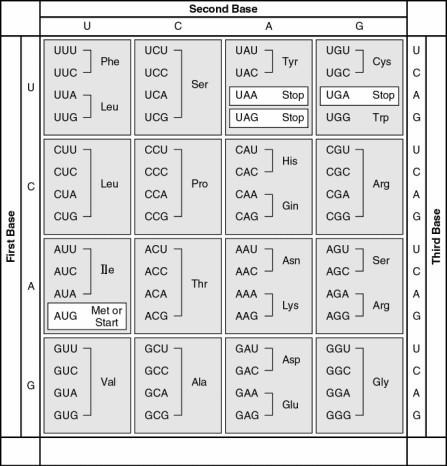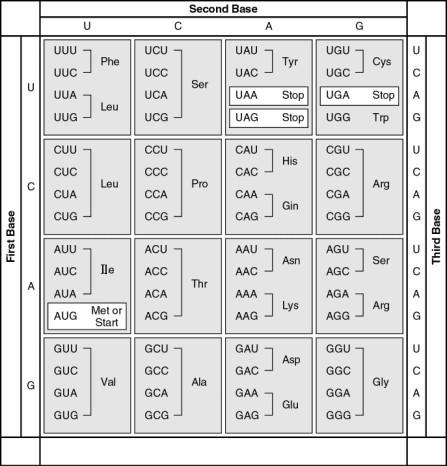
A possible sequence of nucleotides in the template strand of DNA that would code for the polypeptide sequence phe-leu-ile-val would be
a. 3' AAC-GAC-GUC-AUA 5'.
b. 5' AUG-CTG-CAG-TAT 3'.
c. 3' AAA-GAA-TAA-CAA 5'.
d. 5' TTG-CTA-CAG-TAG 3'.
e. 3' AAA-AAT-ATA-ACA 5'.
c. 3' AAA-GAA-TAA-CAA 5'.
Which of the following statements describes the eukaryotic chromosome?
a. It is composed of DNA alone.
b. It consists of a single linear molecule of double-stranded DNA plus proteins.
c. The number of genes on each chromosome is different in different cell types of an organism.
d. Active transcription occurs on heterochromatin but not euchromatin.
e. The nucleosome is its most basic functional subunit.
b. It consists of a single linear molecule of double-stranded DNA plus proteins.
What is a ribozyme?
a. an enzyme that synthesizes RNA as part of the transcription process
b. an enzyme that synthesizes RNA primers during DNA replication
c. an enzyme that uses RNA as a substrate
d. an RNA with enzymatic activity
e. an enzyme that catalyzes the association between the large and small ribosomal subunits
d. an RNA with enzymatic activity
Suppose you are provided with an actively dividing culture of E. coli bacteria to which radioactive thymine has been added. What would happen if a cell replicates once in the presence of this radioactive base?
a. Neither of the two daughter cells would be radioactive.
b. All four bases of the DNA would be radioactive.
c. One of the daughter cells, but not the other, would have radioactive DNA.
d. Radioactive thymine would pair with nonradioactive guanine.
e. DNA in both daughter cells would be radioactive.
e. DNA in both daughter cells would be radioactive.
A frameshift mutation could result from
a. a base substitution only.
b. either an insertion or a deletion of a base.
c. a base deletion only.
d. a base insertion only.
e. deletion of three consecutive bases.
b. either an insertion or a deletion of a base.
At a specific area of a chromosome, the sequence of nucleotides below is present where the chain opens to form a replication fork:
3' C C T A G G C T G C A A T C C 5'
An RNA primer is formed starting at the underlined T (T) of the template. Which of the following represents the primer sequence?
a. 5' A C G U U A G G 3'
b. 5' G C C U A G G 3'
c. 3' G C C T A G G 5'
d. 5' G C C T A G G 3'
e. 5' A C G T T A G G 3'
a. 5' A C G U U A G G 3'
Which of the following investigators was/were responsible for the following discovery?
In DNA from any species, the amount of adenine equals the amount of thymine, and the amount of guanine equals the amount of cytosine.
a. Frederick Griffith
b. Matthew Meselson and Franklin Stahl
c. Alfred Hershey and Martha Chase
d. Oswald Avery, Maclyn McCarty, and Colin MacLeod
e. Erwin Chargaff
e. Erwin Chargaff
Why might a point mutation in DNA make a difference in the level of protein's activity?
a. It might substitute the N-terminus of the polypeptide for the C-terminus.
b. It might substitute an amino acid in the active site.
c. It might exchange one serine codon for a different serine codon.
d. It might result in a chromosomal translocation.
e. It might exchange one stop codon for another stop codon.
b. It might substitute an amino acid in the active site.
The leading and the lagging strands differ in that
a. the leading strand is synthesized at twice the rate of the lagging strand.
b. the leading strand is synthesized by adding nucleotides to the 3' end of the growing strand, and the lagging strand is synthesized by adding nucleotides to the 5' end.
c. the lagging strand is synthesized continuously, whereas the leading strand is synthesized in short fragments that are ultimately stitched together.
d. the leading strand is synthesized in the same direction as the movement of the replication fork, and the lagging strand is synthesized in the opposite direction.
d. the leading strand is synthesized in the same direction as the movement of the replication fork, and the lagging strand is synthesized in the opposite direction.
The genetic code is essentially the same for all organisms. From this, one can logically assume which of the following?
a. DNA was the first genetic material.
b. Different organisms have different numbers of different types of amino acids.
c. A gene from an organism can theoretically be expressed by any other organism.
d. The same codons in different organisms translate into the different amino acids.
e. All organisms have experienced convergent evolution.
c. A gene from an organism can theoretically be expressed by any other organism.
What is the role of DNA ligase in the elongation of the lagging strand during DNA replication?
a. It unwinds the parental double helix.
b. It synthesizes RNA nucleotides to make a primer.
c. It stabilizes the unwound parental DNA.
d. It catalyzes the lengthening of telomeres.
e. It joins Okazaki fragments together.
e. It joins Okazaki fragments together.
A particular triplet of bases in the template strand of DNA is 5' AGT 3'. The corresponding codon for the mRNA transcribed is
a. 3' UGA 5'.
b. 3' ACU 5'.
c. 3' UCA 5'.
d. 5' TCA 3'.
e. either UCA or TCA, depending on wobble in the first base.
c. 3' UCA 5'.
In his transformation experiments, what did British medical officer F. Griffith observe?
a. Infecting mice with nonpathogenic strains of bacteria makes them resistant to pathogenic strains.
b. Mixing a heat-killed pathogenic strain of bacteria with a living nonpathogenic strain can convert some of the living cells into the pathogenic form.
c. Mice infected with a pathogenic strain of bacteria can spread the infection to other mice.
d. Mixing a heat-killed nonpathogenic strain of bacteria with a living pathogenic strain makes the pathogenic strain nonpathogenic.
e. Mutant mice were resistant to bacterial infections.
b. Mixing a heat-killed pathogenic strain of bacteria with a living nonpathogenic strain can convert some of the living cells into the pathogenic form.
When the function of the newly made polypeptide is to be secreted from the cell where it has been made, what must occur?
a. Its signal sequence must target it to the ER, from which it goes to the Golgi.
b. It has a signal sequence that must be cleaved off before it can enter the ER.
c. It has a signal sequence that targets it to the cell's plasma membrane where it causes exocytosis.
d. It must be translated by a ribosome that remains free of attachment to the ER.
e. Its signal sequence causes it to be encased in a vesicle as soon as it is translated.
a. Its signal sequence must target it to the ER, from which it goes to the Golgi.

The following question refers to this figure of a simple metabolic pathway:
According to Beadle and Tatum's hypothesis (developed in their famous bread mold experiments), how many genes are necessary for this pathway?
a. 0
b. 1
c. 2
d. 3
e. It cannot be determined from the pathway.
c. 2
In a nucleosome, the DNA is wrapped around
a. histones.
b. satellite DNA.
c. polymerase molecules.
d. ribosomes.
e. a thymine dimer.
a. histones.
Which of the following is not true of RNA processing?
a. Ribozymes may function in RNA splicing.
b. RNA splicing can be catalyzed by spliceosomes.
c. Exons are cut out before mRNA leaves the nucleus.
d. A primary transcript is often much longer than the final RNA molecule that leaves the nucleus.
e. Nucleotides may be added at both ends of the RNA.
c. Exons are cut out before mRNA leaves the nucleus.
Which of the following would you expect of a eukaryote lacking telomerase?
a. high sensitivity to sunlight
b. inability to repair thymine dimers
c. production of Okazaki fragments
d. a high probability of somatic cells becoming cancerous
e. a reduction in chromosome length in gametes
e. a reduction in chromosome length in gametes

What amino acid sequence will be generated, based on the following mRNA codon sequence?
5' AUG-UCU-UCG-UUA-UCC-UUG 3'
a. met-ser-ser-leu-ser-leu
b. met-leu-phe-arg-glu-glu
c. met-glu-arg-arg-glu-leu
d. met-ser-leu-ser-leu-ser
e. met-arg-glu-arg-glu-arg
a. met-ser-ser-leu-ser-leu
A mutation results in a defective enzyme A. Which of the following would be a consequence of that mutation?
a. an accumulation of product C and no production of products A and B
b. an accumulation of product B and no production of products A and C
c. an accumulation of product B and product C and no production of product A
d. an accumulation of product A and no production of products B and C
e. an accumulation of product A and product B and no production of product C
d. an accumulation of product A and no production of products B and C
What is meant by the description "antiparallel" regarding the strands that make up DNA?
a. One strand contains only purines and the other contains only pyrimidines.
b. One strand is positively charged and the other is negatively charged.
c. The 5' to 3' direction of one strand runs counter to the 5' to 3' direction of the other strand.
d. The twisting nature of DNA creates nonparallel strands.
e. Base pairings create unequal spacing between the two DNA strands.
c. The 5' to 3' direction of one strand runs counter to the 5' to 3' direction of the other strand.
A transcription unit that is 8,000 nucleotides long may use 1,200 nucleotides to make a protein consisting of approximately 400 amino acids. This is best explained by the fact that
a. many noncoding stretches of nucleotides are present in mRNA.
b. there are termination exons near the beginning of mRNA.
c. nucleotides break off and are lost during the transcription process.
d. there is redundancy and ambiguity in the genetic code.
e. many nucleotides are needed to code for each amino acid.
a. many noncoding stretches of nucleotides are present in mRNA.
Cytosine makes up 42% of the nucleotides in a sample of DNA from an organism. Approximately what percentage of the nucleotides in this sample will be thymine?
a. 8%
b. 16%
c. 42%
d. 31%
e. It cannot be determined from the information provided.
a. 8%
Which component is not directly involved in translation?
a. mRNA
b. GTP
c. ribosomes
d. DNA
e. tRNA
d. DNA
For a science fair project, two students decided to repeat the famed Hershey and Chase experiment with bacteriophages, with modifications. They decided to label the nitrogen of the DNA, rather than the phosphate. They reasoned that each nucleotide has only one phosphate and two to five nitrogens. Thus, labeling the nitrogens would provide a stronger signal than labeling the phosphates. Why won't this experiment work?
a. Radioactive nitrogen has a half-life of 100,000 years, and the material would be too dangerous for too long.
b. Although there are more nitrogens in a nucleotide, labeled phosphates actually have 16 extra neutrons; therefore, they are more radioactive.
c. There is no radioactive isotope of nitrogen.
d. Amino acids (and thus proteins) also have nitrogen atoms; thus, the radioactivity would not distinguish between DNA and proteins.
e. Avery et al. have already concluded that this experiment showed inconclusive results.
d. Amino acids (and thus proteins) also have nitrogen atoms; thus, the radioactivity would not distinguish between DNA and proteins.